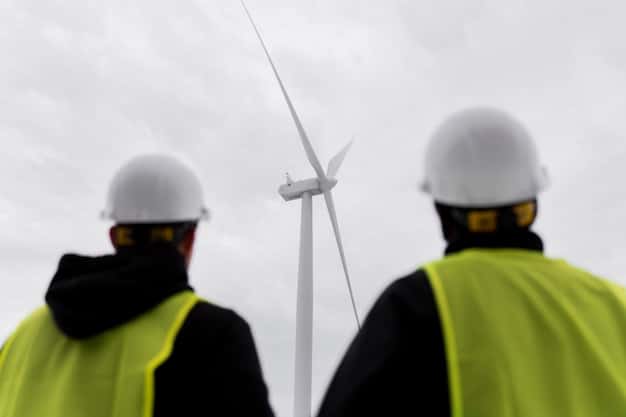Investing in Renewable Energy: Your Guide to Profits in 2025

Investing in renewable energy offers a promising path to sustainable profits in 2025, driven by increasing environmental awareness, supportive government policies, and advancements in renewable technologies like solar, wind, and energy storage.
Are you looking for investment opportunities that not only yield substantial returns but also contribute to a sustainable future? **Investing in renewable energy: A guide to sustainable profits in 2025** can be a game-changer. Let’s explore how you can tap into this burgeoning market responsibly and profitably.
Understanding the Renewable Energy Landscape in 2025
The renewable energy sector is rapidly evolving, and understanding its current state is crucial for making informed investment decisions. By 2025, we can expect significant advancements and broader adoption of various renewable technologies.
Several factors are driving this growth, including heightened environmental concerns, more stringent regulations favoring green energy, and the increasing cost-competitiveness of renewables compared to traditional fossil fuels.
Key Renewable Energy Sources to Watch
Several renewable energy sources are poised for significant growth and investment opportunities in 2025.
- Solar Energy: Solar power continues to expand due to decreasing costs and increasing efficiency. Innovations like perovskite solar cells and bifacial panels are enhancing energy production.
- Wind Energy: Both onshore and offshore wind farms are becoming more prevalent, with larger turbine capacities and improved grid integration technologies.
- Hydropower: While already a mature technology, hydropower is seeing upgrades and better environmental management practices, maintaining its role in the energy mix.
- Energy Storage: The development of advanced battery technologies and other energy storage solutions is crucial for intermittency issues, making renewables more reliable.
These technologies are not mutually exclusive; often, hybrid projects combining multiple renewable sources and storage are becoming more common, offering diversified investment opportunities.
In summary, the renewable energy landscape in 2025 is characterized by technological advancements, supportive policies, and increasing economic viability. Investors who understand these trends are well-positioned to capitalize on the sector’s growth.
Assessing the Risks and Rewards of Renewable Energy Investments
Like any investment, renewable energy ventures come with their own set of risks and rewards. A thorough assessment can help you make informed decisions and mitigate potential downsides.
Understanding these factors is essential for ensuring that your renewable energy investments align with your financial goals and risk tolerance.

Potential Risks in Renewable Energy Investments
Several risks need to be considered before investing in renewable energy projects.
- Policy Changes: Government subsidies and regulations can significantly impact the profitability of renewable energy projects. Uncertainty in these policies can create investment risks.
- Technological Obsolescence: Rapid technological advancements mean that today’s cutting-edge technology could become outdated quickly. Continuous monitoring of technological trends is essential.
- Market Volatility: Fluctuations in energy prices and demand can impact the returns on renewable energy investments. Market analysis and diversification can help mitigate this risk.
- Project Execution Risks: Delays, cost overruns, and operational challenges can affect the financial performance of renewable energy projects. Due diligence and experienced project management are crucial.
Potential Rewards in Renewable Energy Investments
The rewards of investing in renewable energy can be substantial, both financially and socially.
- Financial Returns: Renewable energy projects can offer attractive returns, especially with long-term contracts and stable energy prices.
- Environmental Impact: Investing in renewables contributes to reducing carbon emissions and combating climate change, aligning with ESG (Environmental, Social, and Governance) goals.
- Energy Independence: Renewable energy sources reduce reliance on fossil fuels and imported energy, enhancing energy security.
- Job Creation: The renewable energy sector creates jobs in manufacturing, installation, maintenance, and related industries, boosting economic growth.
Careful risk assessment, coupled with an understanding of the potential rewards, is vital for successful renewable energy investing. Diversification, thorough due diligence, and staying informed about policy and technological trends are key strategies.
Navigating Government Incentives and Policies for Renewable Energy
Government incentives and policies play a crucial role in the renewable energy sector, influencing investment decisions and project viability. Understanding these policies is essential for maximizing your returns.
These incentives and policies can significantly reduce the upfront costs, improve the financial attractiveness, and accelerate the deployment of renewable energy technologies.

Federal Tax Credits and Grants
The U.S. federal government offers several tax credits and grants to support renewable energy projects. Key programs include:
- Investment Tax Credit (ITC): Provides a tax credit for a percentage of the cost of new solar, wind, and other renewable energy equipment.
- Production Tax Credit (PTC): Offers a tax credit based on the amount of electricity generated from renewable sources over a ten-year period.
- Grants and Loan Programs: Various federal agencies offer grants and loan programs to support renewable energy projects, particularly those that demonstrate innovative technologies or benefit rural communities.
State-Level Incentives and Regulations
Many states have their own renewable energy incentives and regulations that can significantly impact investment decisions.
- Renewable Portfolio Standards (RPS): Require utilities to source a certain percentage of their electricity from renewable sources, creating demand for renewable energy projects.
- Net Metering Policies: Allow homeowners and businesses with solar panels to receive credit on their electricity bills for excess energy sent back to the grid.
- State Tax Credits and Rebates: Several states offer additional tax credits and rebates for renewable energy installations, further reducing the costs.
Staying informed about federal and state policies is crucial for renewable energy investors. Government support can substantially improve the economics of renewable energy projects, making them more attractive and profitable.
Identifying Promising Renewable Energy Companies and Projects
Identifying companies and projects with high-growth potential within the renewable energy sector requires thorough research and analysis. Focus on those with innovative technologies, strong market positions, and sound financial fundamentals.
A strategic approach to selecting renewable energy companies and projects can lead to significant returns and contributions to a sustainable future.
Researching Publicly Traded Renewable Energy Companies
Many publicly traded companies are involved in the renewable energy sector, offering opportunities for investment in various segments.
Analyzing financial statements, market trends, and company strategies can help identify promising investment opportunities.
Evaluating Private Equity and Venture Capital Opportunities
Investing in private renewable energy companies through private equity and venture capital firms can offer higher growth potential, but also comes with increased risk.
Thorough due diligence, industry expertise, and understanding the company’s business model are essential for success.
Assessing Renewable Energy Project Bonds
Investing in bonds issued by renewable energy projects can provide a more stable income stream compared to equity investments.
Understanding the project’s financial structure, risks, and long-term contracts is crucial for assessing the creditworthiness of the bonds.
Identifying promising renewable energy companies and projects requires a comprehensive approach, considering financial metrics, market trends, technological innovation, and policy support. Thorough due diligence and a well-diversified portfolio are key to successful investing in this dynamic sector.
Financing Renewable Energy Investments: Options and Strategies
Financing renewable energy projects and investments requires careful planning and access to various funding sources. Understanding the available options and strategies is crucial for securing the necessary capital.
Effective financing strategies reduce the financial burden and improve the overall profitability of renewable energy investments.
Traditional Debt Financing
Traditional debt financing from banks and financial institutions is a common way to fund renewable energy projects. Key considerations include:
- Project Finance: Loans are secured against the project’s future cash flows, allowing developers to finance projects without significant upfront capital.
- Corporate Loans: Companies can use corporate loans to fund renewable energy investments, leveraging their balance sheet and creditworthiness.
- Green Bonds: Bonds specifically earmarked for environmentally friendly projects are gaining popularity, offering attractive financing terms for renewable energy initiatives.
Equity Financing
Equity financing involves raising capital by selling ownership stakes in the project or company. Common equity financing options include:
- Private Equity: Private equity firms invest in renewable energy projects in exchange for equity, providing capital and expertise.
- Venture Capital: Venture capital firms focus on early-stage companies with high-growth potential, often investing in innovative renewable technologies.
- Public Offerings: Companies can raise capital by offering shares to the public through an IPO (Initial Public Offering) or follow-on offerings.
Government Funding and Incentives
Government funding and incentives can significantly reduce the financing burden for renewable energy projects.
Exploring these options can significantly improve the financial viability of renewable energy investments.
Investing in renewable energy requires a diversified approach, combining financial acumen, technological understanding, and a commitment to sustainability. Staying informed, conducting thorough due diligence, and adapting to policy changes are essential for navigating this dynamic market and securing sustainable profits.
Future Trends in Renewable Energy Investing Beyond 2025
The renewable energy sector is set to continue its rapid evolution beyond 2025, with several emerging trends shaping future investment opportunities. Understanding these trends is vital for long-term investment success.
Being aware of these future trends allows investors to anticipate new opportunities and adapt their strategies to maximize returns.
Advancements in Energy Storage Technologies
Energy storage will become increasingly crucial for integrating intermittent renewable energy sources into the grid. Key trends include:
- Advanced Batteries: Lithium-ion batteries are expected to improve in terms of energy density, cost, and lifespan, enabling more efficient energy storage.
- Pumped Hydro Storage: This established technology will see increased deployment, particularly in areas with suitable geography.
- Hydrogen Storage: Green hydrogen produced from renewable energy sources is emerging as a viable option for long-term energy storage and transportation.
Integration of Artificial Intelligence and Machine Learning
AI and machine learning are transforming the renewable energy sector by optimizing energy production, improving grid management, and reducing costs.
These technologies enhance the efficiency and reliability of renewable energy systems, making them more competitive with traditional energy sources.
Decentralized Energy Systems and Microgrids
Decentralized energy systems and microgrids are gaining traction, enabling communities and businesses to generate and manage their own renewable energy.
These systems improve energy resilience and reduce reliance on centralized grids, offering new investment opportunities in distributed energy resources.
As the renewable energy sector advances, innovative companies and projects that embrace these trends will likely offer the most compelling investment opportunities. Staying informed, adapting to change, and adopting a long-term perspective are key to successful investing in renewable energy beyond 2025.
| Key Point | Brief Description |
|---|---|
| 💡 Policy Impact | Government incentives drive renewable energy growth. |
| 🌱 Risk Assessment | Evaluate market and tech risks carefully. |
| ⚡ Promising Sectors | Solar, wind, and energy storage lead the way. |
| 💸 Financing Options | Explore debt, equity, and green bonds. |
Frequently Asked Questions
▼
The primary forces are rising environmental awareness, government support via subsidies and regulations, and improvements that make renewable energy more economically competitive.
▼
Key risks include policy changes, technological obsolescence, and market volatility, which an investor must consider thoroughly before deciding to make an investment.
▼
Government incentives, such as tax credits, grants, and renewable portfolio standards, can significantly reduce upfront costs and improve project financial viability.
▼
Solar and wind energy remain highly promising, with continuous innovation. In addition, energy storage is critical enabling intermittent sources.
▼
Expect advances in energy storage, AI utilization for improved grid management, and more expansion of decentralized energy systems benefiting local communities.
Conclusion
Investing in renewable energy in 2025 presents a compelling opportunity for sustainable profits. By understanding the evolving landscape, assessing risks and rewards, navigating government incentives, and identifying promising companies and projects, investors can contribute to a greener future while achieving financial success.





